Disney princesses’ stories have been a cosmic part of our childhoods, especially for girls. Because, let’s be real, boys didn’t really read princess books, did they? They read books like The Adventures of Pinocchio, Peter Pan and Aladdin. But that’s a discussion for some other time.
Fairy tales transported us into a world full of imagination, simultaneously providing us with our introductory lessons in the understanding of societal norms and gender roles. As a young girl, I was being taught I must be able to cook, clean, sing, dance and, most of all, look pretty all the time. Because Cinderella always did. Snow White always did. So did Ariel and Aurora. Princess paraphernalia constructs an unrealistic and stereotyped representation of an “ideal woman” in young minds and forces them to identify themselves with these typecast gender roles. These fairy tales communicate strong messages pertaining to gender and sex.
Male and female roles are presented differently in fairy tales, establishing distinct ideas about appropriate behaviour for each gender, concurrently normalising the existence of only two genders: male and female. Men are painted to be independent while women are rendered dependent on men; men are depicted as heroic saviours and women as damsels in distress. Prince Charming delivers Cinderella from a life of rags to riches, Prince Phillip liberates Aurora from the sleeping curse and Prince Eric rescues Ariel from the evil sea witch.
Also read: Indian Feminist Fairy Tales: ‘Unprincess’ and ‘Girls to the Rescue’
Notice the bias? These pronounced traits attributed to princes and princesses are suggestive of highly conventional ideals. Men are presented as the dominant gender, possessing immense strength, while women are shown to be submissive, weak and dependent on men for mercy and rescue. Here are some of the lessons our favourite Disney princesses teach us about being women!
Princess Cinderella – Cinderella
Cinderella is the paragon of beauty and virtues an “ideal woman” should possess. She is beautiful, gentle, patient, docile and ladylike. Cinderella’s disposition came to be regarded as general attributes of a desirable woman. In truth, however, Cinderella’s personality is weak. Her helplessness and frailty are glorified as desirable traits.
In the end, Cinderella is rescued by a prince who marries her and ends all her miseries. This is an echo of the idea that women are weaker, dependable beings who need someone, mostly men, to rescue them. Reading the story of Cinderella, therefore, creates an unconscious desire in the minds of young girls to be rescued by a prince, instead of encouraging them to defend themselves.
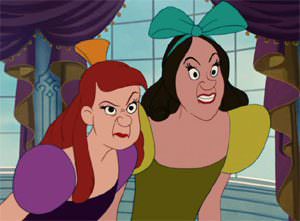
Cinderella’s sisters
Beauty also plays a significant role in Cinderella’s story. Cinderella is a blonde-haired, fair-skinned maiden with beautiful features while her stepsisters had dark hair, darker skin tones and unattractive features. The stepsisters are shown to be quite foolish and oddly dressed, while Cinderella is wise and talented and staged elegantly.
Such illustrations lead to the formation of the idea that dark is ugly. Not only do they create preconceived notions in the minds of children about what is beautiful and what is ugly, but also associate darker skin with negativity, hence sowing the seeds for racist prejudices.
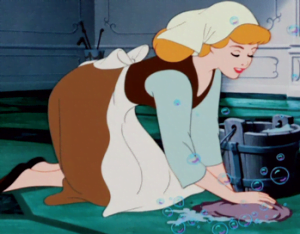
Cinderella doing household chores
Moreover, the princess’ story outlines gender roles in the minds of children. The female characters in the stories are never concerned with the affairs outside of the home. Cinderella is seen doing household chores like cooking, cleaning, sewing, while her stepsisters are seen practising singing and dancing and dressing up. None of them are shown to be concerned about how to provide bread to the family.
Only the stepmother is shown to be concerning herself with the family’s future. Even then, her idea of securing a good future for her daughters is to marry one of them off to the prince, enunciating the idea that a woman’s good future lies only with a man.
Princess Aurora – Sleeping Beauty
The story of Princess Aurora perpetuates the stereotypical gender roles and highlights the underlying patriarchal societal norms. To begin with, Aurora’s character again reinforces the conventional idea of an “ideal woman”. The first of the two fairies gifts Aurora the gift of beauty. Aurora is described with phrases like “hair of sunshine” and “lips so red they shame the red of roses”. The tale often recounts how far the legend of Aurora’s beauty went across the kingdoms.
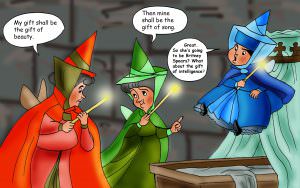
Fairy godmothers giving traits to Sleeping Beauty
Aurora’s second gift was the gift of song. She wasn’t presented with the gifts of courage or wisdom, but only the traits that aligned with the conventional ideas of femininity. These gifts are promoted as the desirable qualities in a woman, as Aurora is able to attract the attention of the prince only because of her song and her beauty. Aurora also appears to be an exemplary of a damsel in distress, who through no fault of her own, is made to suffer until she is rescued by her prince.
Aurora’s father had fixed her marriage with Prince Phillip when Aurora was just a baby. Aurora, upon finding out years later that she is betrothed to a prince of her father’s choice, even though has her heart set on another man, simply cries about her misfortune instead of speaking against it. Aurora wasn’t even consulted regarding the decision of her marriage, much less be allowed to make it on her own. This portrays Aurora to be a victim of patriarchy and teaches young girls to accept the decisions taken for them indisputably.
Princess Ariel – The Little Mermaid
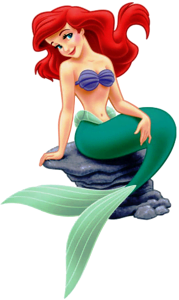
Princess Ariel
The characterisation of Ariel lays a lot of importance on the female body. Ariel, aged only sixteen, is shown to exude sex appeal. Ariel is pictured as quite curvaceous with a tiny waist, invoking the desirability of a thin, petite female body. It reinforces the idea that a woman should be thin and beautiful to be able to attract the attention of men. This creates preconceived standard for an ideal body image in the minds of young girls that they actively try to achieve.
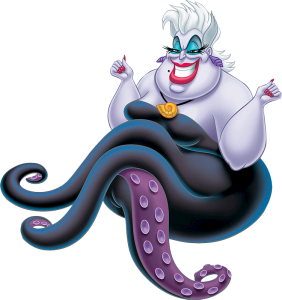
Ursula the evil Queen
In sharp contrast to Ariel is the portrayal of Ursula, the evil sea witch. Ursula has been illustrated with presumably unattractive features — a fat body, ugly-looking (and heavily made-up) face, darker skin and a deep voice — as a way of associating her looks with her wickedness. Ariel’s depiction is meant to symbolise her innocence while Ursula’s of her deviousness. It puts the young minds under the impression that if someone doesn’t fit within the conventional ideas of beauty, they are probably evil.
Ariel willingly sacrifices her voice to transform her whole body simply to become more appealing and acceptable to the prince, knowing he wouldn’t accept her as a mermaid. This suggests that seeking a man holds great importance in a woman’s life and thereby conditions young girls into believing that it’s okay to change themselves for a man. Ariel seeks the love of Prince Eric throughout the story, no matter what she is required to give up in the process.
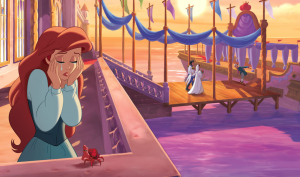
A scene from the Disney movie Ariel
Ariel is a victim of patriarchy as well. Unlike Princess Aurora, Ariel doesn’t simply accept her father’s wishes but sets out to fulfil her own. However, her efforts come to a nought and it comes upon her father and Prince Eric to rescue her, again suggesting women are incapable of protecting themselves and achieving success. Ariel is able to fulfil her dream to be with Prince Eric only after her father permits it, showing how women need approval from the patriarch to achieve what they aspire.
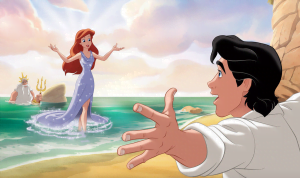
Ariel’s “Happy Ending” – where she literally changed her body for a man.
Princess Snow White – Snow White And The Seven Dwarves
Princess Snow White, too, exhibits the conventional ideas of a perfect woman. Snow White’s stepmother is obsessed with the question of who is the “fairest of them all”, therefore establishing predominance of beauty as the only metric by which women may be judged. Snow White, the heroine, is naturally beautiful.
She is taught to be a dutiful daughter who follows the commands she is given, suggesting that a woman’s domesticated nature is a preferable quality. And when the dwarves go to work, Snow White herself takes the initiative to clean the house and cook for them, thus adding to the stereotypical representation of women as homemakers and men as the bread-earners.

Snow White performing household chores
Snow White serves as the perfect model for a damsel in distress with her subordinate, naive and docile nature. She is instructed by the dwarves to not step out of the house or entertain any guests. However, she is tempted by the shiny red apple that puts her in a coma. This draws a parallel with the story of Eve, reinforcing how a female’s negligence of the instructions given to her by a male result in her downfall.
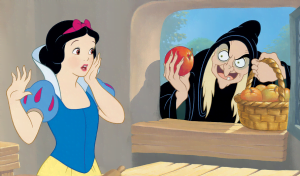
Snow White buying apples
Snow White too displays a weak character, incapable of protecting herself and always at the mercy of men. She is saved from her assassination at the mercy of the huntsman. She is relieved from wandering in the dangerous forest alone due to the mercy of the seven dwarves. And lastly, when she slips into a coma, she is rescued by Prince Charming from her deep sleep. The huntsman, the dwarves and the Prince augment to the idea of male dominance and female dependency on males, constructing an image in the young minds that women need saving and the mercy of men.
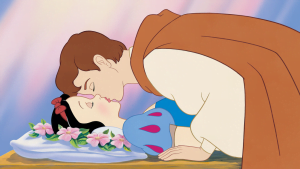
Snow White being kissed by Prince Charming
It is quite evident that the characterisation of all these princesses follows similar stereotypical tropes and provides the children with the same understanding of gender roles that align with the society’s conventional ideas. These stories communicate influential messages that impact a child’s understanding of self and their gender role in the society and that of others. These stories teach them to conduct themselves within the bounds of what is traditionally accepted and what is not.
Disney, with its depictions of princesses Mulan and Merida (Brave), has attempted to stray away from what was conventional. This is a welcome change and we can only hope to see Disney creating more of diverse and strong princesses in the future. If we wish to change the stereotype, the tales for the children need to be changed first.
About the author(s)
Shagun Gupta is a fiction enthusiast and an amateur photographer, currently embarking on a writing career after having recently earned her post-graduate degree in Mass Communication.




